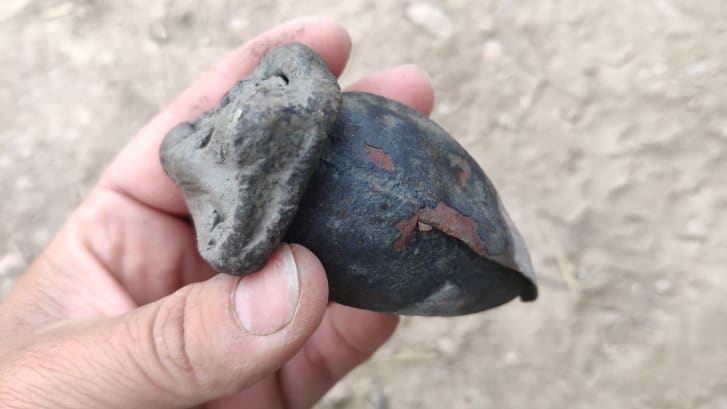Archaeologists recover unique ancient objects from Tuscan hot springs
Categories: Nálezy nejenom s detektorem v západní Evropě
San Casciano dei Bagni is one of Italy's top destinations with hot springs that have been visited for over 2,000 years. The present-day town is located just a few metres from the ancient spa complex. Archaeologists have discovered thousands of well-preserved artefacts here. They are revealing new insights into the interconnectedness of the cultures of the time with healing springs and religion.
The thermal baths are part of a network of pools built by the Etruscans as early as the 4th century BC. They were later built upon by the Romans. The local geothermal hub consists of 40 hot springs. Six are directly connected to the thermal sanctuary. The Etruscans used the therapeutic power of the mineral-rich water, such as calcium and magnesium, as well as salts and sulphates.
The inhabitants of San Casciano have long called this place the "sacred mountain". A geophysical survey in 2019 first revealed the presence of structures at the springs. The following year, ancient columns were discovered and this year, after a covida "pause", excavation work began. Last week, archaeologists discovered a collection of artifacts and relics that shed new light on the intimate connection of ancient Italian civilizations to the "water religion" or the healing, divine origins of hot spring water.
The ancient thermal baths functioned as a hospital clinic where patients sought relief from various ailments. As thanks for their healing, they threw various objects into the water. Archaeologists have now recovered rare votive offerings from the mud. Among others, fertility statuettes in the shape of a penis, a woman's womb or a pair of breasts. Also 3,000 ancient coins, 700 of which have not been circulated. They are still in excellent condition and high lustre.
"The site is unique in the Mediterranean for its state of preservation and the evidence that confirms the perception of thermalas medicinal under divine protection," said archaeologist Jacopo Tabolli, director of the excavation project and professor of Etruscan studies at the University of Siena. "The quantity and quality of the objects found is also astonishing - we knew there was something down there, but we didn't expect such a surprise," he added.
The number of bronze, silver and orichalcum coins found in the large bath is extraordinary. It is the largest coin set associated with hot springs in the Mediterranean. It is also unique for their state of preservation due to the chemical properties of the water as well as the anaerobic environment: "They are still shiny brown and yellow - coins of such bright colors have never been found at any excavation site," Tabolli said, adding, "It's a miracle."
Throwing the coins into the water to thank the gods and the healing power of the springs was apparently an ancient custom. In the third century AD, the Roman emperor Marcus Aurelius Carus had coins thrown into the baths in tribute to the gods who to watch over his health and that of all Romans travelling to San Casciano for treatment in the thermal springs. Very unique are the bronze miniatures of legs, arms and ears. They were probably used to give thanks for the healing of these particular parts of the body or to draw attention (ear-shaped objects) to the prayers of mortals in pain.
"During Etruscan and Roman times, votive offerings were usually made of terracotta. The bronze finds at San Casciano are the first of their kind," Tabolli said. "They serve as evidence of how important this thermal site was. The discoveries tell us a lot about ancient Italian communities and advance our understanding ofour study of their social, cultural and religious customs in light of the sacred nature of hot water."
An Etruscan pool was uncovered at the excavation site, which, with a length of eleven metres and a depth of five metres, is known as "and five smaller Roman pools where hot water still flows at a rate of about 7,000 litres per minute. Alongside the travertine stone altars are the ruins of fountains and statues of the god Apollo, the fertility goddess Isis and the goddess of the firstborn Fortuna Primigenia.
Health treatments at the thermal baths included rituals specifically related to pregnancy and childbirth. The discovery of a statue of a naked child leads archaeologists to believe that ancient women visited San Casciano during pregnancy and after childbirth in the hope of protecting the health of their child. Similar practices were known until modern times: "As recently as 50 years ago, village women who had problems conceiving a child would come to the thermal baths, believing that the water would help them and relax their wombs," Tabolli explained.
The newly opened museum in the 16th-century building will soon present the unearthed wonders to the public. Local authorities and experts believe the baths still hold more treasures. In the deepest muddy layers, they suspect objects from the Etruscan era. Archaeologists hope to get to them soon.
Roman Nemec
Sources: edition.cnn.com, intoscana.it, archeologiaviva.it

A bronze cast of a woman's womb

Bronze ear as a votive gift

Detail of the sanctuary

Among the finds were thousands of exquisitely preserved coins

A penis-shaped offering

A collection of bronze ears

Finds of terracotta

A shrine with a bath

An international team of archaeology students is taking part in the excavations

The Great Sanctuary of Apollo
The article is included in categories: